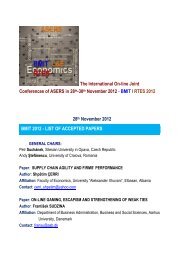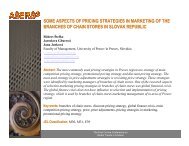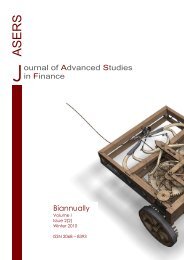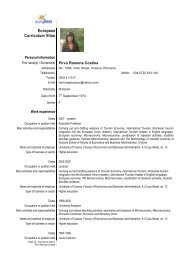Can Shift to a Funded Pension System Affect - ASERS
Can Shift to a Funded Pension System Affect - ASERS
Can Shift to a Funded Pension System Affect - ASERS
Create successful ePaper yourself
Turn your PDF publications into a flip-book with our unique Google optimized e-Paper software.
%<br />
Theoretical and Practical Research in Economic Fields<br />
5.5<br />
5<br />
Estimated values<br />
Actual values<br />
4.5<br />
4<br />
3.5<br />
3<br />
2.5<br />
2<br />
1.5<br />
1999 2000 2001 2002 2003 2004 2005 2006 2007 2008<br />
Figure 1. Day-<strong>to</strong>-day rate (actual and estimated values)<br />
The coefficient on exchange rate has two functions. On the one hand, it impacts on the constant and so<br />
we have <strong>to</strong> jointly consider these values. On the other hand, it obviously indicates the marginal effect produced by<br />
a variation of the exchange rate on the nominal interest rate. We can infer an important information analysing this<br />
coefficient: an appreciation of about 30 cents of the exchange rate (that is, the Euro has strengthened against the<br />
dollar) induces the ECB <strong>to</strong> cut the interest rate of about 100 basis points.<br />
Given this analysis, it is evident the importance of the nominal Euro-Dollar exchange rate in determining<br />
the decisions of the ECB‟s monetary policy.<br />
This prominent attention <strong>to</strong>wards this exchange rate can also explain the reduction of the coefficient on<br />
inflation gap that has a lower value than the ones estimated in the previous models.<br />
Figure 1, as I have said before, shows the estimated and the actual values obtained with this last model.<br />
The two series diverge in a considerable way during the second half of 2006. Starting from that period, the model<br />
does not manage <strong>to</strong> well reproduce the path of the day-<strong>to</strong>-day interest rate.<br />
Given this result, it seems that during the last period of the sample there has been a change in the<br />
managing of the Euro area monetary policy. If it was true, this fact should have caused interference on the<br />
estimated series.<br />
So, I have thought <strong>to</strong> repeat the regression with the same model but over a shorter sample. I have<br />
eliminated the last period, in which the two series diverge, and so the sample now starts in January 1999 and<br />
ends in June 2006.<br />
Table 4 shows the results of this last regression and Figure 2 illustrates the path of the estimated and<br />
actual values of the Euro area day <strong>to</strong> day interest rate.<br />
Coefficients are always highly significant and they have the right sign, but the value of the coefficients has<br />
changed in comparison with the previous regression. The constant and the coefficient on the exchange rate have<br />
changed most of all. But if we remember the analysis suggested in the previous pages, we can only see a change<br />
in the marginal impact of the explana<strong>to</strong>ry variables on the dependent variable. Indeed, the constant and the<br />
coefficient on the exchange rate have <strong>to</strong> be jointly evaluated. Even in this case, if we compute in the right way<br />
this linkage, we will find a constant around 2.5.<br />
At a first sight, we could consider <strong>to</strong>o small a value of 0.60 for the coefficient on inflation gap, but we<br />
should remember that in this model the ECB reacts in a very sharp way <strong>to</strong> fluctuations of the Euro-Dollar<br />
exchange rate. Following my results, the ECB should cut the interest rate by 1 per cent point if the Euro-Dollar<br />
nominal exchange rate grows by 20 basis points. If we consider these two effects at the same time, the impact of<br />
the coefficient on inflation gap and on exchange rate, and if we bear in mind the impact of this exchange rate on<br />
inflation, a value of 0.60 on inflation gap is acceptable. In addition a low value of the coefficient on the inflation<br />
gap is showed in other works <strong>to</strong>o, see Ullrich (2003).<br />
48











